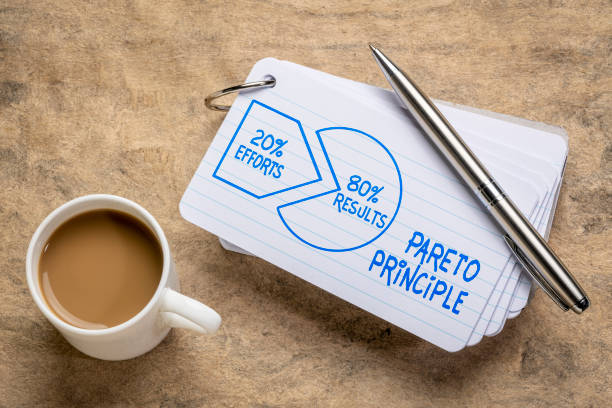This article may contain references to products or services from one or more of our advertisers or partners. We may receive compensation when you click on links to those products or services. Nonetheless, our opinions are our own.
The information presented in this article is accurate to the best of our knowledge at the time of publication. However, information is subject to change, and no guarantees are made about the continued accuracy or completeness of this content after its publication date.
In most parts of life and business, the effort doesn’t always pay off. On the other hand, a small number of actions often lead to most of the results. Vilfredo Pareto, an Italian economist, was the first to see this big difference in the late 1800s. People now call it the Pareto Principle or the 80/20 rule.
The principle states that approximately 80% of the outcomes derive from merely 20% of the efforts, inputs, or resources. Since Pareto’s time, when wealth was divided up, this idea has been a good way to think about productivity, efficiency, and making decisions. It still works today in business. It now goes well beyond economics and has an impact on how businesses make their operations more efficient, how people use their time, and how industries choose which improvements to make first.
We’ll talk about where the Pareto Principle came from, how it connects to ideas like Pareto Efficiency, and how to use the 80/20 rule in your daily life, both at home and at work. By figuring out which actions have the biggest impact, people and businesses can focus better, waste less time and effort, and get better results with less stress.
- The 80/20 Rule and Its Origins
- The Birth of the Pareto Principle
- From Economic Theory to Universal Application
- The Basics of Pareto Efficiency
- What is Pareto Efficiency?
- The Link Between the 80/20 Rule and Pareto Efficiency
- A Beginner’s Guide to Applying the 80/20 Rule
- What You Need to Get Started
- Practical Applications of the 80/20 Rule
- Enhancing Business Operations
- Conclusion
- Frequently Asked Questions
- Recommended Reads
The 80/20 Rule and Its Origins
The 80/20 rule says that focusing on a few important tasks can help you get the best results. It tells us to work smarter, not harder. Not every task is equally important. By concentrating on the most important 20%, people and businesses can get better results and be more productive.
This idea has changed the way we think about managing our time, being productive, and using our resources. It shows where our work and results don’t match up. It makes us want to work on things that matter a lot.
The Birth of the Pareto Principle
Vilfredo Pareto first noticed this trend in the late 1800s when he looked at how wealth was shared in Italy. He discovered that just 20% of the people owned 80% of the land. He saw the same patterns in other places, like the plants he grew in his garden, as he looked into it more.
These observations led to the creation of the Pareto Principle. The principle says that a small number of inputs often lead to most of the results. This notion exemplifies a power-law distribution. In this case, small changes in one area can have a big effect on another.
Pareto first used this idea in economics, but it has now changed how people manage businesses, make software, and get things done.
From Economic Theory to Universal Application
The Pareto Principle was first thought of in the field of economics. Business expert Joseph Juran took this idea and ran with it. He realized that the 80/20 rule can also be used to manage quality. He said that only 20% of the processes usually cause 80% of the problems.
Juran’s ideas changed the way we look at quality management. Companies started to find the main problems to fix for better results. Now, the Pareto Principle is used by many industries:
- 80% of a company’s sales usually come from 20% of its customers.
- 80% of customer complaints often come from 20% of product issues.
- 80% of project progress is often made with 20% of the work.
The Basics of Pareto Efficiency
Pareto Efficiency is a way of thinking about how to use resources in the best way possible. It means that no one can feel better without making someone else feel worse. The 80/20 rule tells us which tasks have the most effect. Pareto Efficiency, on the other hand, tries to get the best results with less.
What is Pareto Efficiency?
Richard Koch, a writer and business expert, makes Pareto Efficiency easier to understand. He talks about how important it is to use resources wisely. It’s not just about finding the important 20% that makes things work better; it’s also about making sure those parts help the whole thing work better while cutting down on extra work.
People and groups can make better decisions if they know how inputs affect outcomes. This will help them be more productive and use their resources better.
Voted "Best Overall Budgeting App" by Forbes and WSJ
Monarch Money helps you budget, track spending, set goals, and plan your financial future—all in one app.
Get 50% OFF your first year with code MONARCHVIP
The Link Between the 80/20 Rule and Pareto Efficiency
The 80/20 rule helps you get better results by finding the few things that make the biggest difference. Tools like Pareto charts can help you figure out which things are most important. This method helps you focus on the changes that will have the biggest effects.
You need to keep checking and changing things to get to Pareto Efficiency. Companies and people can make things work better and waste less by regularly looking at their priorities.
A Beginner’s Guide to Applying the 80/20 Rule
The 80/20 rule doesn’t need big changes. To begin, look for places where small actions lead to big changes. This could be a long list of things to do that doesn’t help much or a marketing plan that doesn’t make much money. The goal is to focus on the most important things instead of getting rid of less important ones.
What You Need to Get Started
You need to change how you think in order to follow the 80/20 rule. You don’t need any new tools. First, take a look at the work you have and the goals you want to reach. Find tasks where your work doesn’t match the results you get. Then, focus on the few important things that will get you good results.
The rule is more of a suggestion than a strict formula. Instead of worrying about exact percentages, try to tell the difference between activities that have a big effect and those that don’t. Using this method can help you get more done and be more effective.
Step 1: Identifying Key Areas of Impact
Start by thinking about how you use your time at work and in your everyday life. Ask yourself:
- Which tasks need a lot of effort but give back little?
- Which activities help the most with getting things done and achieving goals?
For instance, a long meeting that could be replaced with a clear email saves time. You might need to look over a marketing channel that uses resources but doesn’t give results. Focusing on the most important tasks helps you get more done and feel less stressed.
Step 2: Looking at the 20% That Affects the 80% Outcomes
After you find the main areas, use Pareto charts to separate activities that are worth a lot from those that aren’t. This study will help you make smart use of your time and money.
Understanding this distribution makes it clear that we don’t have to get rid of all the less important tasks. It tells us which things we need to pay more attention to.
| Task Type | Action Plan |
|---|---|
| High Impact, Low Effort | Prioritize for maximum efficiency |
| High Impact, High Effort | Streamline to improve effectiveness |
| Low Impact, Low Effort | Maintain as long as they don’t drain resources |
| Low Impact, High Effort | Consider reducing or eliminating |
People and businesses can focus on the best things to do with this plan. This plan helps them get more done and get good results.
Practical Applications of the 80/20 Rule
The 80/20 rule is helpful in a lot of different situations. It helps you get more done and makes your business more successful. If you know how to use this rule, it can make your work a lot better, whether you’re managing tasks or running a business.
Improving Personal Productivity
In our busy world, managing time is critical. The 80/20 rule makes it easier to plan by focusing on the most valuable tasks. For example:
- Starting the workday with a big project instead of emails helps get more done.
- Having focused work times reduces distractions and makes work better.
When you find important tasks, you can use your time better. These practices will lower your stress and help you get better results.
Enhancing Business Operations
The 80/20 rule is used by top companies to make their businesses better. Microsoft is a good example. They use Six Sigma to find and get rid of waste. Pareto charts help you figure out what factors have the biggest effect on performance.
| Business Area | 80/20 Application Example |
|---|---|
| Sales | Focusing on the 20% of clients generating 80% of revenue |
| Marketing | Optimizing the most effective channels |
| Customer Service | Addressing the 20% of issues causing 80% of complaints |
| Product Development | Prioritizing features for core users |
By using the 80/20 rule, businesses can boost their productivity and profits.
Conclusion
We can change how we work and make decisions by learning and using the 80/20 rule. People and businesses can do better work by finding the most important areas and focusing on them. These ideas show us how to make the most of what we have, which will help us be successful for a long time.
Frequently Asked Questions
How Can I Identify the 20% in My Life or Business?
Make a list of your most important tasks and see how much work they take compared to how much they pay off. Use a Pareto chart to find the most important tasks and show the differences.
Is the 80/20 Rule Universally Applicable?
The Pareto principle is not a hard and fast rule, but it is often used in business and in everyday life. This makes it a useful tool for figuring out what matters most.
How often should I look at the 80/20 distribution again?
Regular checks, especially after big changes or important events, help things run smoothly.
Can the 80/20 Rule Work in Relationships?
It shows the things we do that have the biggest impact on how good our relationships are and how well we talk to each other.
Are There Limitations to the 80/20 Rule?
It works best when you use it as a guide and not as a rule. For the best results, it’s important to know how different efforts work together.

Reviewed and edited by Albert Fang.
See a typo or want to suggest an edit/revision to the content? Use the contact us form to provide feedback.
At FangWallet, we value editorial integrity and open collaboration in curating quality content for readers to enjoy. Much appreciated for the assist.
Did you like our article and find it insightful? We encourage sharing the article link with family and friends to benefit as well - better yet, sharing on social media. Thank you for the support! 🍉
Article Title: How Pareto Efficiency is Used in Business, Economics, and Investing
https://fangwallet.com/2025/08/19/how-pareto-efficiency-is-used-in-business-economics-and-investing/The FangWallet Promise
FangWallet is an editorially independent resource - founded on breaking down challenging financial concepts for anyone to understand since 2014. While we adhere to editorial integrity, note that this post may contain references to products from our partners.
The FangWallet promise is always to have your best interest in mind and be transparent and honest about the financial picture.
Become an Insider

Subscribe to get a free daily budget planner printable to help get your money on track!
Make passive money the right way. No spam.
Editorial Disclaimer: The editorial content on this page is not provided by any of the companies mentioned. The opinions expressed here are the author's alone.
The content of this website is for informational purposes only and does not represent investment advice, or an offer or solicitation to buy or sell any security, investment, or product. Investors are encouraged to do their own due diligence, and, if necessary, consult professional advising before making any investment decisions. Investing involves a high degree of risk, and financial losses may occur including the potential loss of principal.
Source Citation References:
+ Inspo
There are no additional citations or references to note for this article at this time.












































